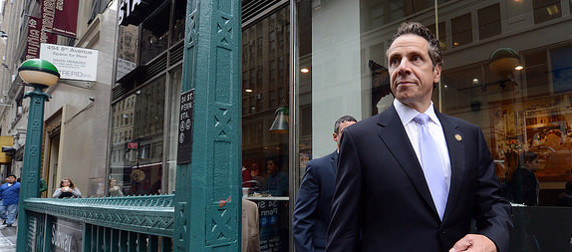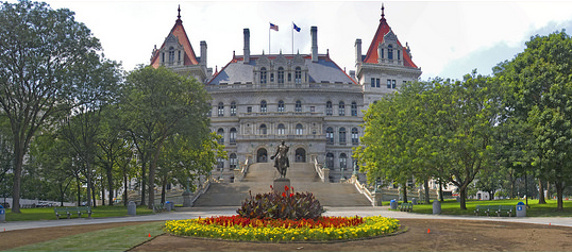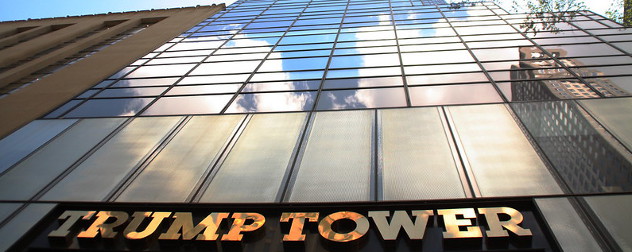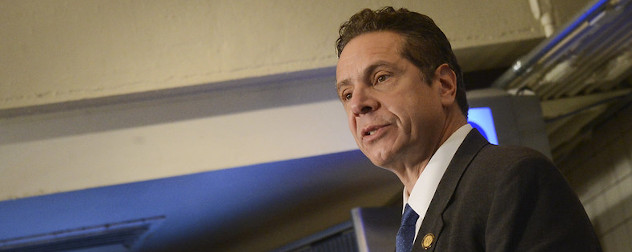I am at the Orlando World Center Marriott in Florida this week, attending the nation’s premier conference on estate planning along with seven of my colleagues and more than 2,000 other leading practitioners in this field.
Not a single one of us – not me, not my colleagues, and I’ll venture to say none of the other attendees here at the doorstep of Walt Disney World – wishes the University of Miami Law School would move its Heckerling Institute on Estate Planning to Queens, N.Y.
Granted, there probably are a few estate planners in metropolitan New York who would be more likely to attend the conference if it were near home. But there is only one person in the universe who thinks he can persuade convention-goers from Florida, or Illinois, or Virginia, or California (or almost anywhere else) to park themselves on the shores of Jamaica Bay for a week in January. This person sleeps in the governor’s mansion in Albany.
In his State of the State address last week, Gov. Andrew Cuomo outlined his plan to “generate billions of dollars in economic growth” for the self-proclaimed Empire State. Number one on the agenda is to tear down the Jacob Javits Convention Center in Manhattan and replace it with a bigger, better convention center near John F. Kennedy International Airport in Queens.
Demolishing the Javits Center is an idea worth considering. Putting a new center in one of the outermost parts of the outer boroughs, a solid hour’s subway ride from midtown Manhattan, is not. The fact that Cuomo proposed it makes me wonder whether he is experimenting on himself before calling for the decriminalization of marijuana.
Cuomo’s imagined convention center would feature a 3.8-million-square-foot exhibition hall, allowing it to take the title of largest convention center in the nation from Chicago’s 2.67-million-square-foot McCormick Place. Naturally, Cuomo is counting on someone else to pay for the construction of this behemoth. His proposal rests on a planned public-private partnership with the Malaysian Genting Group, which operates the casino at the Aqueduct Racetrack, the proposed convention center’s next-door-neighbor-to-be.
The bill for the convention center, along with a hotel and additional gambling space, is expected to be around $4 billion. So far, the Genting Group has entered into a nonbinding agreement to finance the project. The idea that the private sector would put up $4 billion to build a white elephant this conspicuous without the government getting on the hook for a large share of the cost, plus a fortune in infrastructure, should be taken with a large grain of salt. Make that a boulder of salt.
In his apparent eagerness to build the biggest convention center, Cuomo failed to examine how the nation’s current largest convention center is actually performing. Citing the Chicago Tribune, a recent Wall Street Journal article reported that Chicago’s McCormick Place operates at only 55 percent capacity. Convention centers in other cities around the country have been similar flops.
Despite its preferable location, the Javits Center has failed to live up to expectations as a boost to New York’s tourism industry, which has done very well without it. The Javits Center does host its fair share of conventions, but most of the participants are locals, so the convention center does little to generate business for hotels and restaurants. Meanwhile, it occupies a piece of land that could be worth up to $4 billion, as Robert Yaro, president of the Regional Plan Association, told the New York Times. (The fact that this equals the estimated cost of Cuomo’s pipe dream in Queens is, at least, an interesting coincidence.)
After demolishing the Javits Center, the city would lead the way in the development of a planned community including housing, hotels and museums. Battery Park City, at Manhattan’s southern tip, has been promoted as a successful model.
It might make excellent sense to knock down the Javits Center and put that valuable property to better use - not to mention back on the tax rolls. If he had stopped with this suggestion, I would be offering kudos to Cuomo for broaching the subject. There are many good reasons why private hotels, like the Marriott where I am staying this week, should finance their own convention spaces if they think they will attract sufficient business, and if they believe it is the best use of their real estate.
The Heckerling Institute used to be housed at the Fontainebleau Hotel on Miami Beach. That venue lost the business some years back when it underwent a renovation. The Marriott has held on, even after the Fontainebleau reopened, because of its superior facilities and competitive nearby attractions. Such is life in the private sector.
Meanwhile, a few miles away from the Marriott, Orlando’s municipal convention center is struggling along with the rest of the industry. The Florida United Numismatists left town yesterday. The convention center is dark through Wednesday. On Thursday it lights up again with the Surf Expo, the Art 4 Clean Air art contest, and the 2012 Martha’s Sewing Market put on by Martha Pullen, Inc. Friday brings the Orlando Spring Home and Garden Show. It is safe to say that central Florida’s hospitality industry is not waiting with bated breath for any of these events.
The convention industry is struggling everywhere. From 2000 to 2010, the number of convention attendees dropped from 126 million to 86 million people. The rise of on-line webinars and other technology-driven substitutes is likely a major factor, along with elevated domestic travel costs as fewer airlines fly with fuller planes. Yet in that same period, the amount of convention space increased from 53 million square feet to 70 million square feet. In attempts to increase their market share, cities sank ever-increasing sums of money into building ever-bigger convention centers, further devaluing the space. Cuomo proposes to take this trend to its most illogical extreme.
Given all the options for convention sites and the low level of interest in attending conventions altogether, organizers have no choice but to focus on hosting conventions in places where people already want to go. And the plain truth is that almost nobody wants to go to the far reaches of Queens.
Then there’s the problem of the climate. Aside from McCormick Place, which is in downtown Chicago, the country’s other largest convention centers are in Orlando, Las Vegas, Atlanta and New Orleans. All of those places are decidedly sunnier than Queens.
The Genting Group, or any other private party, would have to be stupid to expect that it could recoup a $4 billion investment on the Queens convention center. I doubt the company’s managers are stupid. However, I also seriously doubt a Genting spokesman’s statement that the company’s stated willingness to fund the convention center is unrelated to the governor’s recently expressed support for a constitutional amendment to legalize table games in casinos.
“Though Genting Americas supports the governor's constitutional amendment legalizing table games in New York, our plans for a privately funded, $4 billion convention center are not predicated on that amendment,” the spokesman, Stefan Friedman, told The Wall Street Journal. I’ll believe this when Genting, or any other private investor, actually puts billions of dollars in cash on the table without government financial backing. But don’t bet on it.
Cuomo may be trying to win back the favor of New York’s influential labor unions, whom he offended last year with fairly hard-line positions on budgets and taxes. Or he may be trying to appear as a visionary with high aspirations for his state ahead of the 2014 re-election campaign for governor and a possible presidential candidacy in 2016.
But here in sunny Florida, Cuomo does not sound like a visionary with high aspirations. He sounds like he’s just high.













January 9, 2012 - 2:03 pm
Dear Mr. Elkin, I just read your post, “Cuomo’s Folly,” and felt compelled to comment. Perhaps my comments are picayune, but then again maybe you could consider some outside perspective regarding your thoughts on convention hall location and operating capacity.
You raise the issue that relocating a convention center to Queens would be a “solid hour’s subway ride from midtown Manhattan.” My first impression was that you were lamenting the distance you would have to travel (as a local) to attend events at the proposed location. I was going to be quick to point out that as a person who would exhibit at the Javits or the proposed facility, I would be traveling anywhere from 5-8 hours, with a load of materials and a physical booth set up, either Manhattan or Queens, so I was rather unsympathetic to your concern about a short subway ride. I understand (perhaps assume), on reflection that you likely meant that would mean tourist dollars and convention spending diverted from downtown Manhattan. So okay…
…You go on to mention that convention business is trending down while facility growth is trending up. Regardless of convention center size, perhaps one of the most important contributing factors on whether I’ll exhibit at a trade show or convention, or host a trade show/conference, or even attend one, is the combined costs. And, in my opinion, the cost to be utilize the Javits Center (exorbitant space costs, all the unionized add-ons for move in, shipping/receiving, parking, show services, travel, lodging, etc.) are some of the most prohibitive I’ve encountered in the trade show industry, by the thousands of dollars.
For example, a simple booth space at the Javits Center for the NY Times Travel Expo (http://www.nyttravelshow.com/exhibitors.html) would have a base cost of $3,400. Add onto that the costs incurred to pay for moving exhibit materials into place (not to mention the costs if one chooses to ship them and have them received by the exhibit hall, an added costs), parking (figure minimum $20 per day), and lodging (figure $150-200 day if lucky), meals, etc. I would spend a quarter of that cost tops to attend any consumer travel show across the country or in Canada, as well as any events featuring meets/greets with travel writers (such as the convention for the Public Relations Society of America and Society of American Travel Writers).
Needless to say, myself and many of my colleagues in the New York State tourism promotion industry are cutting our costs by scaling back attendance at events held at the Javits Center, including our colleagues at “I Love New York,” the state’s tourism promotion agency.
I’m pretty certain, though, the Javits Center will not reduce its rate to events and exhibitors any time soon, and I won’t hold my breath that a new hall is built in Queens would prove any less expensive to attend.
For the record, I am currently the marketing director for the state’s private campground owners association, and I am a board member and Immediate Past President of the New York State Travel & Vacation Association. I also chair and produce the annual Empire State Tourism Conference, which has yet to be held in New York City, I’ll note here (exhibit space at our event in Albany, NY on March 6-7 starts at a reasonable $975, let me know if you’re interested 😉 ). We Upstaters aren’t cheap, but we are frugal and budget-conscious and we try not to go where we can’t afford to.
Best regards!